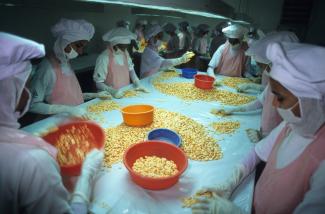European Union
The EU is not taking policy coherence seriously

According to Phil Hogan, the EU commissioner for agriculture, the future looks bright for European farmers. At the International Green Week, a trade fair, he stated in Berlin in January: “The demand for food is rising worldwide; all signs are positive”. He sees no conflicts of interest in his export strategy, even though imported food from rich nations can undermine local farmers’ competitiveness in developing ones. In the Commission’s recently published coherence brochure, Hogan praises the EU’s economic partnership agreements (EPAs) with countries in the African, Caribbean and Pacific (ACP) group of states as well as the openness of the EU market to agricultural imports from the global South as positive examples of “the practical implementation of policy coherence”.
But what does “policy coherence for development” (PCD) really mean? The concept is simple: powerful states and blocs of states like the EU must draft policies in important policy areas in a way that does not conflict with their own international-development objectives. Ideally, all policies would actively promote development. For development efforts to succeed, policy coherence matters especially in the areas of trade and finance, climate change, food security, migration and security, the EU’s Foreign Affairs Council has stated.
The European Commission reviews its own activities and those of its member states every two years. The most recent report was published in 2013. Since 2009, these progress reports have considered impacts on developing countries.
The statement by Commissioner Hogan that we have quoted above indicates a basic problem, however: very few officials in Brussels take the notion of policy coherence seriously or are committed to applying it in practice. At the highest political level, PCD is nothing more than empty rhetoric, as the following three examples show.
EPAs
Only by placing an enormous amount of pressure on numerous partner countries did the EU manage to conclude EPAs with regional communities in West Africa (ECOWAS), Eastern and Southern Africa (ESA), East Africa (EAC) and Southern Africa (SADC) last year. Brussels even threatened to end tariff preferences on 1 October 2014 for middle-income countries that refused to enter into EPAs.
In West Africa in particular, partner organisations of Misereor, a Catholic non-governmental organisation, worry that the tariff reductions the EPAs grant imports from the EU will reduce opportunities for African farmers to sell dairy products, poultry, tomatoes and other goods on local markets. These organisations see the EPAs as a threat to local smallholders’ human right to food.
Conversely, the EU’s Commission for Agriculture argues in its brochure that the EPAs are in line with development policy because they allow the ACP states to continue to exclude up to 20 % of their products from trade liberalisation. But even when it comes to these sensitive products, the EPAs forbid African countries from raising current tariff rates. That means that the countries will no longer be able to take advantage of the leeway they have so far been given by the WTO to modify rates. The tariff rate for milk powder is currently only five percent in West Africa for example. This low rate will offer no protection from powerful EU competition should world markets decrease.
The European Commission also calls attention to its “generous” offer to end subsidies for agricultural exports to West Africa. The truth is, however, that these subsidies have been almost phased out anyway, regardless of the EPA. However, the EU still subsidises farmers with direct payments worth an annual € 40 billion, and those subsidies also allow them to sell goods below production costs.
Biofuels
A second critical area is the EU’s biofuel policy, particularly as it is driving land investments in the global South. The EU plans to increase the portion of renewables used in the transport sector to seven percent. For all practical purposes, this goal creates a blending rate for biofuel, which, in combination with considerable subsidies for biofuel production, encourages land grabs in the global South. In 2013, the Commission itself issued a report admitting that “some” problematic land investments had been made in developing countries with an eye to providing the EU with biofuels.
A study by the German Institute of Global and Area Studies (GIGA) assessed the issue realistically in 2014. The authors relied on data from the Land Matrix Global Observatory, a non-governmental outfit. They state that, in 956 registered land acquisitions by transnational investors, almost a fourth of the area purchased was taken over for growing biofuels or “flex-crops” such as sugar cane, which can be used for food or fuel purposes, depending on market conditions.
The GIGA team found that African countries are particularly affected by land acquisitions that relate to biofuel production. Most of the investors were from the EU: five EU countries – the Netherlands, Britain, France, Italy and Spain – were among the top countries where investors were based, with 190 investments geared exclusively to biofuel production.
The study identified significant risks. Contrary to investors’ assertions, the acquired land is rarely dry or marginal. The authors stress that there is a great deal of competition for arable land and access to water and infrastructure.
Policy coherence is clearly only an afterthought for EU policy makers in regard to such a sensitive issue like land investments. The issue only comes up after large-scale investments have been made. The EU ought to operate according to the precautionary principle, but it does not examine the potential consequences of investments in advance.
Corporate power in the retail industry
Another blind spot in the EU’s assessment of policy coherence is the issue of social standards, labour rights, human rights and the sharing of profits in global product chains. Retail corporations wield an enormous power in the EU’s food industry. They put considerable price pressure on producers in the global South.
According to Germany’s Federal Cartel Office, the four largest German food retailers account for 85 % of the nation’s consumption volumes. The situation is similar in 10 other EU countries. In each, at most seven companies control over 70 % of food sales. Such market power creates pricing pressure and leads to problematic labour standards for suppliers – both within the EU itself and, to an increasing extent, in developing countries. In 2013, consumer-protection organisations concluded that only about half of the 25 largest food retail companies in the EU pay attention to the labour standards that are in place in third countries where they source the goods they sell with their own labels.
Similar ignorance is evident in the fact that only four of the 25 companies have any kind of fair purchasing policy in regard to fresh fruits and vegetables. Many retailers rely on voluntary codes of conduct, especially the Business Social Compliance Initiative (BSCI). But BSCI audits are performed randomly. Only a very small portion of fresh fruits and vegetables is ever subjected to a rather superficial review. Many investigations have shown that massive labour and human rights violations occur in these sectors.
Our three examples show that the EU’s approach to policy coherence is flawed. Two central issues are obvious:
- First, the declared commitment to PCD will remain nothing more than empty rhetoric if the EU does not make a serious effort to obtain empirical information. Doing so would require appropriate systems of indicators as well as an analysis of impact chains. The EU uses a system of indicators to check its trade policy, but it is misleading. For example, it accepts the number of concluded EPAs as proof of policy coherence, even though an impact analysis would have to be carried out to determine whether the EPAs themselves serve coherence. What is needed is a fundamental reform of the current method of assessing sustainability in the trade sector.
- The second problem is that the basic premises of the EU’s policies undermine real opportunities for development. When the European Commission celebrates the forced increase in exports of milk powder and pork as a contribution to global food security, for instance, or when EPAs are described as a way to promote development, the EU’s true commitment to policy coherence for development is put in doubt.
Benjamin Luig is an advisor on agricultural policies and nutrition at Misereor, a Catholic NGO based in Germany.
benjamin.luig@misereor.de
Kerstin Lanje is also an advisor on agricultural policies and nutrition at Misereor.
kerstin.lanje@misereor.de
Armin Paasch is an advisor on business and human rights at Misereor.
armin.paasch@misereor.de















